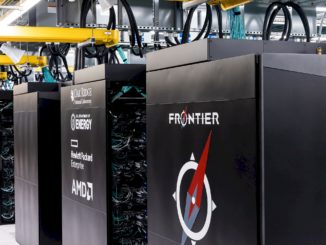
If incumbent storage suppliers want to have a business in the hybrid cloud world, they have to find ways to erase the line between what’s in the cloud and what’s on-premises – and increasingly what’s at the edge. Data and applications will be at all three locations, and in a sense, there is not really a datacenter so much as a data galaxy.
The data movement across the data galaxy needs to be easy, infrastructure has to be adaptable, and management, security, and analytics have to extend through all tiers of that compute and storage space.
And everything has to have cloud-like flexibility and consumption models, which is why all of the major OEMs have been converting their hardware and software portfolios, sold transactionally, to services sold under subscription. Hewlett Packard Enterprise is doing it through its GreenLake platform, as are Dell with Apex, Lenovo with TruScale, and Cisco Systems with Cisco+, among others. If the storage cannot be put literally on a cloud – as Pure Storage has done with its Purity storage software stack – then it had better be so cloud-like that it appeals and the OEM tools had better bring cloud storage under the same management scheme as the on premises stuff.
For the past two years, HPE has been rapidly building out its cloud-based storage portfolio, breaking it away from its Apollo brand and creating its line of Alletra storage arrays. During that time, the company rolled out the Alletra 9000 for latency-sensitive workloads and the Alletra 6000 for high availability, and then the Alletra 5000 for non-all flash workloads. January saw the introduction of the server-based Alletra 4000, complete with Intel’s new “Sapphire Rapids” 4th Generation Xeon SP CPUs.
Now comes the Alletra MP, a new disaggregated storage cluster that offers a flexible, common hardware platform for multiple storage formats – initially block and file but inevitably brining object, we think – that can be configured for either or both either and easily scaled, and is lashed together via an NVM-Express interconnect.
Alletra MP, announced today at an event in Houston along with expanded and new file and block storage services that run on the hardware, provides a Lego-like infrastructure that can be configured however the organization needs.
“There’s nothing new in your datacenter,” Omer Asad, senior vice president and general manager of cloud data services for HPE, told journalists at a virtual press briefing. “It’s the same IP-based control fabric which everybody uses. These building blocks, just like Lego blocks, are now attached into the fabric. You can give it a personality – you can give it a file personality or you can give it a block storage personality on the back end. It’s shared-everything. It’s the same controller that can be configured for performance or it can be configured for capacity. It allows us for a simplistic supply chain methodology and allows our customers to stock these boxes ahead of time and on demand as needed. Both of the personalities of these boxes are controlled by a single cloud control plane.”
It is latest addition to an Alletra business that has grown over the past several quarters. According to HPE’s first-quarter numbers, the vendor’s storage business generated almost $1.9 billion, a 5 percent year-over-year increase, and an operating budget of $142 million, representing 12 percent of storage revenue. That’s down from previous quarters due to more R&D money going into the portfolio, HPE says.
HPE is aiming the GreenLake storage business at “data-first” organizations that are modernizing their environments with a focus on data management, said Patrick Osborne, senior vice president and general manager of HPE’s Cloud Data Infrastructure unit. These companies are seeing advantages – they’re faster getting new products to market and recovering from ransomware attacks, for example – but it’s also creating challenges with data lifecycle management as workloads run from on premises out to the cloud and edge and legacy tools fail to keep up with modern demands.
“Point solutions are not catering to these newer workload demands,” Osborne said at the briefing. “When we talk about legacy apps vs. some Mode 1 [for backend IT operations] vs. Mode 2 applications [modular and cloud-native] – these new styles of programing, these new styles of application delivery, cloud services – point solutions aren’t keeping up with the unpredictable data growth and changing storage needs for these types of applications.”
Riding atop the hardware are the new and expanded storage services, including a new GreenLake for File Storage service aimed at data-intensive and volume workloads – such as AI, deep learning, and big data – that need scalability and simplified management as the amount of data being generated accelerates. It’s read performance is 80 times that of legacy NAS systems and comes with a read throughput of hundreds of gigabytes per second. It supports the NFS and SMB protocols.
Asad said the service is “mainly targeted towards unstructured workloads, targeted toward next-generation applications, and it delivers a radical simplicity to deliver you disaggregated performance scaling and capacity scaling on top of a standard file architecture,” adding that it runs on the same Alletra MP hardware that the block service does.
The file service is designed to scale to the exabyte level, pulling together the GreenLake cloud environment with flash storage provider Vast Data’s software. HPE also is moving its 3PAR block storage to run on the disaggregated Alletra MP platform, with the aim of bringing cloud-like speed, flexibility, and economics – 66 percent better price-performance than other offerings, HPE says – to on-premises environments.
Whither object storage? Osborne said the focus now is on file and block, but added that what’s offered with Alletra MP will expand.
“Object storage is a phenomenon out there and we’re starting to see either workloads that have been born in the cloud coming back and being deployed in production on-premises, and a lot of that from Mode 2 applications that tends to be object from a protocol in the way you organize your information,” Osborne said. “That’s an opportunity for both HPE and some of our partners to deliver on today and an opportunity for GreenLake cloud platform tomorrow.”
HPE also is rolling out GreenLake for Disaster Recovery – leveraging Zerto’s technology – and for Backup and Recovery services. The vendor launched the Backup and Recovery service on GreenLake in November 2022 and is now adding cloud-native backup capabilities. In addition, HPE is growing its VMware backup capabilities by adding SQL backup features.
The file and block storage services are orderable now, with Backup and Recovery generally available. Enterprises can start ordering GreenLake for Disaster Recovery in June.
All of this will be useful for both enterprises and midmarket companies.
“A lot of the needs are the same but at different scales,” Osborne said. “The ability to scale down and scale up, that’s both from essentially a performance and capacity perspective as well as a pricing perspective. A number of smaller customers, mid-sized customers, need solutions that are economical. … We can have a full-on solution for private or hybrid cloud for a small customer. They can have compute, networking, and storage, they can have block, they can have file, they can certainly have all the data services that go along with it at a small footprint and help them with challenges around consumption for capital outlay. This can also scale up to the enterprise.”
Features like fleet management and provisioning and protecting workloads in on-prem and in the cloud can help a broad array of organizations, he said.








Be the first to comment